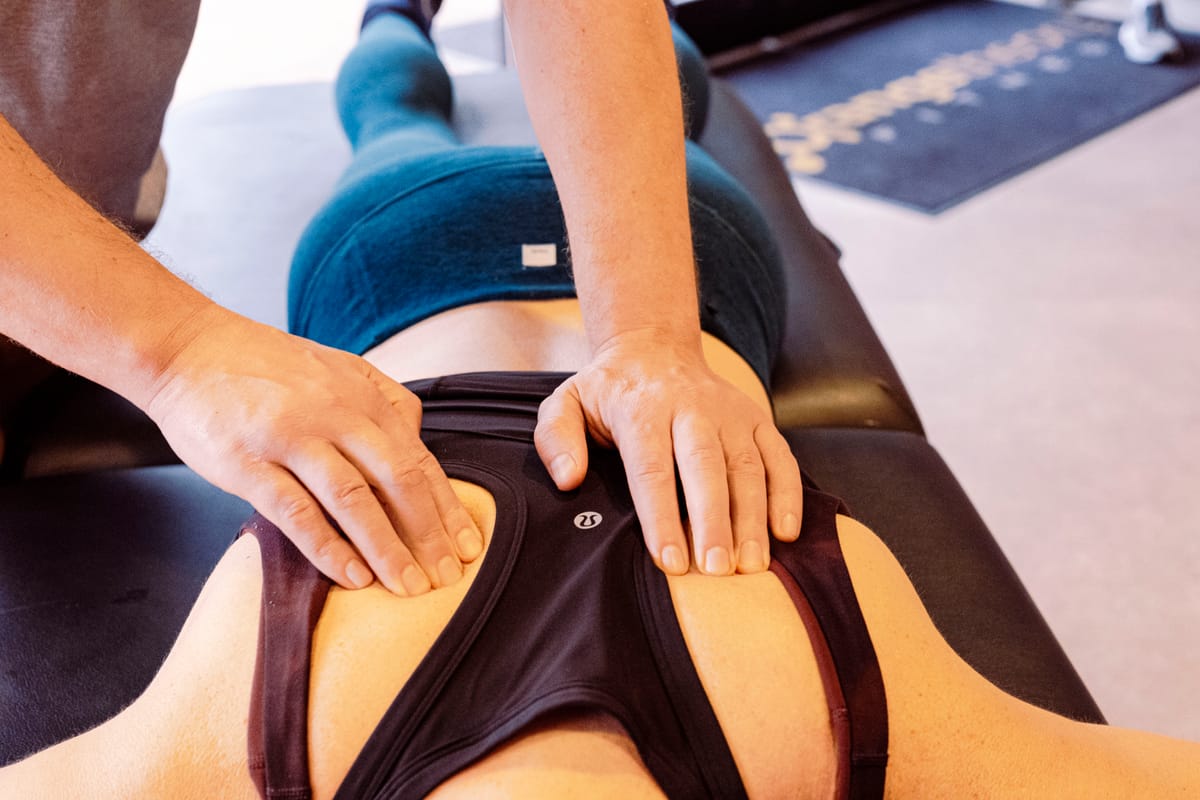
Benefits of Trigger Point Therapy
releasing trigger points—small, tight knots that form in muscles.
What is Trigger Point Therapy?
Trigger point therapy is a specialized form of massage therapy that focuses on detecting and releasing trigger points—small, tight knots that form in muscles.
These knots are sensitive and can cause significant pain or discomfort, often referring pain to other parts of the body. Trigger point therapy aims to alleviate these symptoms by applying pressure to these specific areas, helping to release the tension and restore normal muscle function.
This therapeutic approach is particularly beneficial for individuals who experience chronic pain, muscular overuse, or those recovering from injuries.
What Are The Benefits of Trigger Point Therapy?
- Pain Relief: Trigger point therapy targets specific knots or "trigger points" in muscles, effectively relieving localized pain and discomfort.
- Improved Range of Motion: Trigger point therapy can enhance flexibility and improve joint range of motion by addressing muscle tightness and restrictions.
- Headache and Migraine Relief: Many headaches and migraines are associated with muscle tension. Trigger point therapy can alleviate this tension, reducing headache frequency and intensity.
- Enhanced Circulation: Trigger point therapy's massage techniques can stimulate blood flow, promoting better circulation. Improved circulation aids in delivering oxygen and nutrients to muscles, supporting overall health.
- Postural Improvement: Addressing trigger points helps correct muscle imbalances, which can contribute to better posture. Working on trigger points is especially beneficial for individuals who spend long hours sitting or have sedentary lifestyles.
- Stress Reduction: Trigger point therapy induces relaxation, reduces stress, and promotes well-being. Its benefits include positive effects on mental and physical health.
- Faster Recovery from Injuries: Trigger point therapy can help individuals recover. It aids in healing by improving all-important blood flow to the affected area.
- Prevention of Chronic Pain: Regular trigger point therapy can help prevent the development of chronic pain conditions by addressing muscular issues before they become more severe.
Trigger Point Therapy with Iler Method®
The Iler Method incorporates trigger point therapy as a key component of its broader therapeutic strategy. While trigger point therapy focuses on localized tight areas within muscles that can cause referred pain elsewhere, the Iler Method integrates this with a comprehensive evaluation of the body's muscular and structural balance.
Our evaluation includes a thorough Discovery Session encompassing a formal intake from the client, a walking discovery to identify asymmetries, and an on-table pain assessment. This detailed initial evaluation ensures the treatment addresses each client's unique needs and conditions, setting a solid foundation for effective therapy.
We forgo oils, allowing clients to dress comfortably during their sessions. So, there is no need for a post-session shower, facilitating the incorporation of treatments into busy schedules and contributing to a more straightforward and less intrusive therapeutic environment.
By eliminating music, the setting encourages more open communication, allowing for better feedback between the client and therapist. Additionally, this approach minimizes excessive stretching, focusing on the muscle bellies rather than just the insertions, where the most significant tension relief and therapeutic work are often needed.
This holistic and personalized strategy ensures that each session effectively targets individual health needs in a supportive and efficient manner.
Iler Method Techniques
The Iler Method uses specialized fingertip and thumb techniques to locate and identify Trigger Points and Adhesions in and around the most painful spot. We call the most painful area the “local pain.”
Once trigger points and adhesions are discovered, therapists rotate through eight specialized techniques to address them.
1. Elbow
The elbow is one of the more versatile manual therapy tools. It can be highly effective because it allows the therapist to apply a large amount of pointed force to most of the posterior muscles and deeper trigger points and adhesions.
2. Open Palm
The open palm is a tool underutilized by most therapy modalities. Although it's less precise and useful for detailed work, it makes up for that in total coverage of larger areas, including muscles that often need a good amount of pressure.
3. Ridge of the forearm
The therapist sustains pressure for extended periods on areas more dense with the ridge of the foreman, which is effective for softening tissue.
4. Knuckles
Knuckles deliver a good amount of pressure per square inch. They are especially effective in Iler Method ® Therapy sessions because this technique relieves specific pain points.
5. Thumb over thumb
The thumb-over-thumb technique multiplies the amount of pressure possible. It is a precise tool that can generate much downward pressure. It is an under-hooking tool for muscles that larger body parts like the elbow, knuckles, or forearm can't access.
6. Hand and fingers over fingers
This technique multiplies the amount of pressure applied. It is used in areas requiring pressure and finger sensitivity, such as the neck muscles.
7. Straight fingers
This tool effectively assesses and addresses even the finest trigger points, adhesions, and spaces between muscles. Iler Method therapists train to use this highly specialized technique.
8. Ring and middle finger together [H3]
No other combination of fingers, including the thumb, is stronger or more structurally sound for working with muscles that must be manually separated.
Final Thoughts: Trigger Point Therapy
Trigger point therapy offers targeted relief, breaking down knots and easing muscle tension to restore mobility and comfort. Its precise application helps alleviate acute and chronic pain, making it an integral tool for enhancing daily function and quality of life.
The Iler Method® goes a step further, integrating effective techniques within a holistic treatment plan that meticulously caters to individual needs, paving the way for quicker recovery and improved movement.
Our distinctive approach forgoes the need for oils and background music, ensuring that each session is focused and efficient. We not only address clients' direct needs but also fit easily into busy schedules.
By enhancing the dialogue between therapist and client, the Iler Method optimizes the effectiveness of each session, making it an invaluable approach for anyone committed to maintaining or improving their physical health through therapeutic practices.
Disclaimer -
Please note that at Iler Method® Therapy, we specialize in massage therapy and related techniques. All clients must understand that we are not medical professionals, and our services should not be seen as a substitute for medical advice, diagnosis, or treatment. Our practices are designed to support and complement your overall health, but they do not replace professional medical consultation when needed.
Trigger Point Therapy Benefits: FAQs
What does trigger point therapy help with?
Trigger Point Therapy helps clients by targeting and alleviating localized areas of muscular tension, known as trigger points. This relieves pain, improves flexibility, and enhances overall muscle function.
Is trigger point therapy good for you?
Trigger Point Therapy can be beneficial for many individuals experiencing muscular tension, pain, or restricted movement, such as neck pain, TMJ, Thoracic Outlet Syndrome, low back pain, and piriformis syndrome.
What happens when a trigger point is released?
Releasing a trigger point through Trigger Point Therapy facilitates restoring normal muscle function, resulting in immediate or gradual pain relief, increased flexibility, and improved range of motion.
How long should you press on a trigger point?
The duration of pressure applied to a trigger point during Trigger Point Therapy can vary depending on factors such as the individual's tolerance, the severity of the trigger point, and the specific technique used. Generally, sustained pressure is applied for 30 seconds to a few minutes, allowing the tissue to release and the muscle to relax.
Is trigger point therapy safe?
Trigger-point therapy is safe when administered by a qualified practitioner. However, safety is subjective and can vary for each individual. You should listen to your body and trust your intuition when getting bodywork. Iler Method therapists train for years to achieve “ideal pressure” during trigger point therapy sessions.
How often can you do trigger point therapy?
The frequency of Trigger Point Therapy sessions can vary depending on individual needs, the severity of muscular issues, and the practitioner's recommendations.
Clients may benefit from weekly sessions initially, while others may find relief with less frequent sessions.
At Iler Method, we assess each client individually and devise a treatment plan for them and their needs.
Is trigger point therapy painful?
Trigger Point Therapy can sometimes be uncomfortable, as the therapist applies pressure to specific areas of tension or trigger points in the muscles.
The pressure is often described as "good pain," meaning it may be intense but should not be unbearable.
Who does trigger point therapy?
Trigger Point Therapy is performed by licensed healthcare professionals such as massage therapists, physical therapists, chiropractors, osteopaths, and medical doctors with expertise in manual therapy. At Iler Method, we exclusively focus on trigger point therapy.




